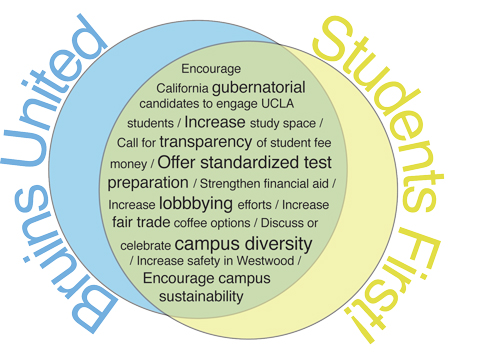“VOTE FOR Students First!” reads the Facebook status of party faithfuls with election season in full swing. Yet it is somewhere between foolish and ignorant to follow this advice. But this is not an advertisement for either slate, as voting for that slate is just as unwise.
Students should be voting for individual candidates based on platforms, ideas and experience, not semi-organized party affiliations, because each candidate presents his or her own strengths and differences.
Party politics at this level is unnecessary since Undergraduate Students Association Council members only serve in their position for one year and are only directly affected by their decisions for a few years after their term at most. The slates largely only spring up during election time.
But this political mindset is fixed into the system and has become the norm since 2005 when Bruins United and Students First! became the two major slates on campus. This does not mean that we must fall into this system’s tricky ways of making students want to vote solely for one slate or another.
The two main slates were formed around separate issues. According to Jasmine Hill, the Students First! candidate for president of USAC, the Students First! slate generally assumes the position of social justice and has grassroots background in meeting the needs of students.
Bruins United, on the other hand, came about in 2005 because of issues with student group funding and has since been focused on making USAC friendly for student groups and getting students involved in student government, according to Luz Maria Kumpel, the Bruins United candidate for president of USAC.
While the slates are rooted in different causes, many of their goals and platforms today are not that different. Both slates’ websites include at least ten goals that are similar or the same (see graphic) for USAC.
If everyone voted along slate lines, then these elections would be simply a popularity contest for the slates, and the winning student government would not be representative of students’ views.
All candidates have platforms that can be found on the election websites. If you really want to be an informed voter, go to each slate’s website (votestudentsfirst.com and bruinsunited.com), read their statements, talk to the Bruinwalk representatives of these groups, or even contact the candidates. There are ample options to be an informed voter.
“Students should take the time to read through the platforms and the (coverage, then) decide for themselves,” said Kumpel.
The traditionally low voter turnout, between 17.2 and 38.9 percent in the last decade, is embarrassing since voting has been made easier by use of MyUCLA. It is always a surprise that a majority of students do not vote for their student government, especially because it controls a hefty budget of almost $3 million derived from student fees. All undergraduate students have vested interests in the election.
The percentage of informed voters, who are not voting just based on slate affiliation or only for friends, is sadly even lower. It should be noted that if you end up voting for one slate after reading all platforms, that is acceptable informed voting.
“People may end up voting on party lines, but that is not my emphasis,” said Hill.
The candidates’ debate was held Saturday in Northwest Campus Auditorium which has a capacity of 350. No more than 19 people were watching the live stream. This means that only about 1.4 percent of UCLA undergraduate students watched the candidates debate ““ a sad number at best.
This has a larger implication, in that university campuses like ours likely have some of the highest per capita education levels in the world and yet we are disenfranchised from educated democracy.
If you have made it this far into this column, you likely are part of the third of students that will vote, but it needs to be said anyway: Go be an informed voter if you have not already.
E-mail Ramzanali at aramzanali@media.ucla.edu. Send general comments to viewpoint@media.ucla.edu.
